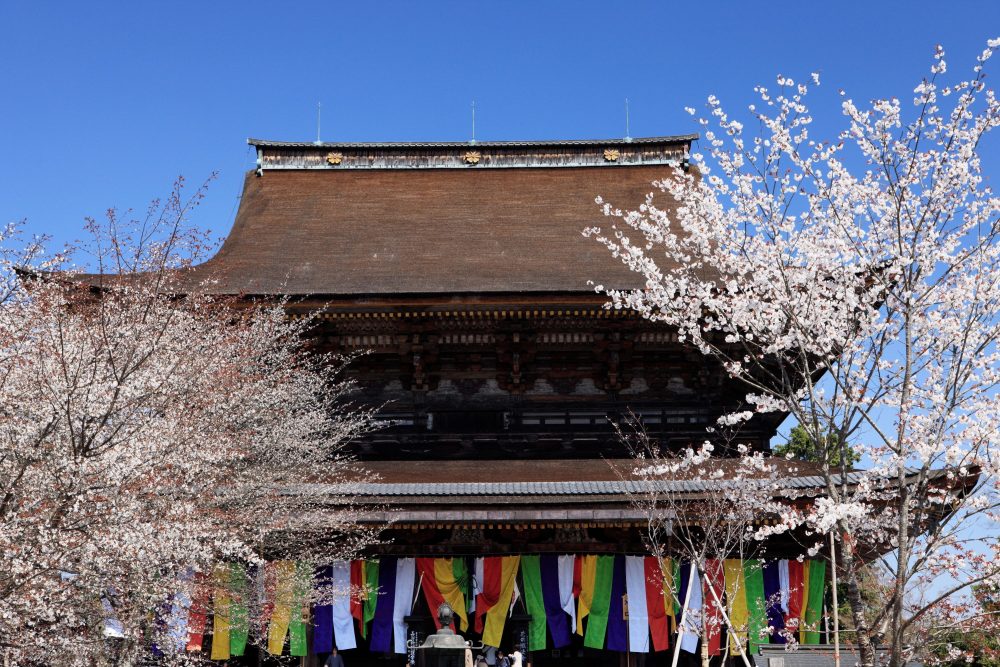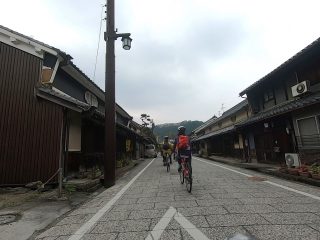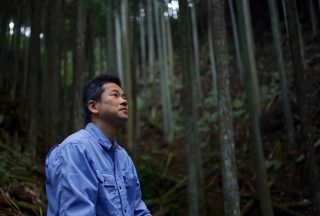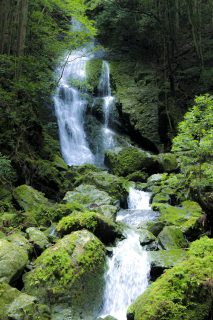1.
Mountain Mystics: Exploring Yoshino’s Shugendo Faith
For most Japanese and foreign visitors, Yoshino evokes cherry trees and cherry blossom viewing, but if you look a little closer, you might also spot people dressed in distinctive yellow or white robes, carrying staffs and conch shells. These are mountain ascetics (yamabushi or shugenja), and they practice Shugendo, a unique Japanese belief system of mountain asceticism with deep roots in Yoshino as well as on Mt. Koya, or Koyasan, to the southwest.
Shugendo literally means “the way of shugen,” which refers to ascetic practices such as fasting, meditation, chanting sutras, and praying under waterfalls. Founded in the 7th century by En no Gyoja or En the Ascetic (634–ca. 700), a legendary mystic and sorcerer, Shugendo is a highly syncretic belief system. It fuses the ancient worship of mountains as sacred spaces where spirits of the dead reside with folk beliefs such as shamanism and elements from Shinto, Buddhism, and Esoteric Buddhism. Shugendo developed into a coherent belief system in the late 12th century but only recently came to be affiliated with the Esoteric Buddhist sects of Tendai and Shingon. The Honzan-ha school of Shugendo is associated with Tendai Buddhism and the Tozan-ha school associated with Shingon.
The sacred mountains of Shugendo include Mt. Omine and Mt. Katsuragi in Nara Prefecture as well as mountains in the Kumano region of Wakayama Prefecture and the Mountains of Dewa in Yamagata Prefecture. Practitioners undergo austerities and physical hardships in the mountains in order to develop spiritual powers that can benefit the larger community. Entering the mountains represents a transition from a profane to a sacred realm, including the realm of the dead, and austerities symbolically elevate practitioners into Buddhas.
But Shugendo involves more than mountain asceticism. It also has a rich history of temple worship. The principle temple of Shugendo in the Yoshino region is Kinpusenji, which is traditionally believed to have been founded by En no Gyoja in the seventh century. Since then, this temple has been an important stop on pilgrimage routes. Zaodo, the main hall, was completed in 1592 and is now both a National Treasure and the second-largest wooden building in Japan (after the Great Buddha Hall of Todaiji Temple). The main deity Zao Gongen, originally Shinto gods that are also a manifestation of the historical Buddha and of the bodhisattvas Maitreya and Kannon. With its monumental height of roughly seven meters and its bared teeth on a fierce countenance, the cherry wood statue of Zao Gongen in the Zaodo cuts an imposing figure. The deity’s wrath, however, is that of a stern parent scolding the children as it directs the people of the world to the path of enlightenment. Also a manifestation of the historical Buddha, the deity is flanked by similar giant Zao Gongen statues representing the bodhisattvas, Miroku and Kannon.
During the Meiji era (1868–1912), the government tried to impose a separation of Shinto and Buddhism in Japan, effectively outlawing syncretic faiths such as Shugendo. Nearly all its sites became either Shinto or Buddhist, and practitioners were forced to become Shinto priests or Buddhist monks. This changed with the 1947 Constitution’s guarantee of religious freedom, and today Shugendo is a thriving community of lay practitioners and ordained monks striving for spiritual growth through communion with nature and rigorous training.
——————————————————————————————————
2.
Mountain High: The Ascetic Practices of Shugendo’s Yamabushi Monks
Shugendo practitioners have a reputation for toughness. These mountain ascetics (yamabushi, “those who sleep in the mountains” or shugenja, “those who undergo spiritual training”) subject themselves to freezing cold and stifling heat, as well as fasting, meditation, and long-distance endurance treks in the wilderness, all to develop spiritual powers and help protect their communities.
As a loose collection of belief systems, Shugendo is open to all people, including ordained monks and lay practitioners; laymen are known as ubasoku and laywomen ubai. While some of its sacred mountains are off-limits to women due to ancient beliefs about the jealousy of Shinto kami goddesses, there are many female practitioners.
Yamabushi can often be identified by their distinctive costume. Although there are variations according to sect, they usually wear small black caps (tokin), yellow or white robes (suzukake), pelts (hisshiki), and straw sandals (yatsume waraji). The accouterments may include a staff (shakujo), pompom sash (yuigesa), and conch trumpet (hora). These clothes and tools are important equipment for journeying into the mountains for spiritual training. The main exercises of Shugendo are known as nyubu or mineiri, “entering a mountain,” and involve walking in the mountains and climbing a sacred peak.
The ascetic practices of yamabushi may be as extreme as chanting Buddhist sutras while dangling from the top of a cliff, which is aimed at conquering fear, or as simple as walking meditation along mountain paths, a practice akin to moving Zen meditation. The Omine-Okugake Trail, a Shugendo training path, links Yoshino and Mt. Omine to the Kumano region, the site of three grand Shinto shrines known as the Kumano-sanzan. The route, which winds through panoramic vistas from Yoshino to Kumano Hongu Taisha shrine, is nearly 100 kilometers long and takes about five days to complete. Along these trails are multiple places to undergo spiritual training, including caves, cliffs, and rivers. Shugendo practitioners embark on training courses of varying lengths that can be split up into shorter treks. The 1,000-day Mt. Omine training course, which has been completed only twice in the past 1,300 years, is said to take more than seven years to complete.
Training in and around one’s village home is another form of Shugendo practice. This can be something as simple as praying for peace, or something more elaborate like the fire ritual held at Shugendo temples, which involves intense chanting of sutras while sitting before and feeding a steadily intensifying bonfire. The ritual is a prayer for world peace, for the recovery of a sick person, or for spiritual purification.
Shugendo, though, is inseparable from mountain asceticism. Aside from leaving behind the ordinary, profane world to enter a sacred space in the wilderness, yamabushi are also symbolically undertaking a mystic journey into the realm of the dead, who were traditionally believed to reside in the mountains. In a Buddhist context, yamabushi also cleanse themselves of former lives in previous reincarnations. The mountain ranges in the Koyasan, Yoshino, Omine, and Kumano regions of the Kii Peninsula are considered representative of both the Womb Realm and the Diamond Realm, which are central to the cosmology of Esoteric Buddhism. By communing with these spirits, the yamabushi can pray for the safety and enlightenment of all people.
——————————————————————————————————
3.
The Sacred Routes of Shugendo: Pilgrimages to Koyasan and Kumano
If you walk the mountain trails of the Kii Peninsula east of Osaka, you can hear the sound of conch horns echoing through the woods. This is the sound of yamabushi, the practitioners of the belief system known as Shugendo, who blow these shells as they make their pilgrimages through the mountains. Pilgrimages through the wilderness are an essential part of Shugendo, a faith blending Shinto, Buddhism and mountain worship. The Koyasan Route and the Kumano Route, two important routes in the discipline of Shugendo, attract spiritual devotees and casual hikers, who can enjoy the magnificent mountain vistas along these routes.
Located in Wakayama Prefecture, Mt. Koya, or Koyasan, is a mountaintop religious retreat established in 819 by the Buddhist monk Kukai (also known as Kobo Daishi; 774¬–835), one of Japan’s most venerated religious figures. With its complex of temples, schools, and the large graveyard Okunoin, Koyasan has served for centuries as a place of spiritual purification and learning. Although seven mountain trails lead to Koyasan, the Koyasan Choishi Michi Pilgrimage Route is one of the most important for mountain ascetics. Created in the ninth century, it is the original access route to Koyasan. The route stretches about 24 kilometers from Kudoyama to Okunoin and takes some 7 hours to complete. Beginning at Kudoyama Station on Nankai Electric Railway’s Koya Line, the route goes northwest to Jisonin Temple, which has a memorial hall built by Kukai in honor of his mother and a statue of Maitreya, the Buddha of the future, which is now a National Treasure.
Jisonin had also been the traditional beginning of the route, which soon turns southward and ascends into the mountains. The Choishi Michi is named for the 180 stone stupas that line the path. Placed there in the Kamakura period (1185–1333), these stupas symbolize five-storied pagodas, which are tall, slender buildings serving as repositories for relics of the historical Buddha. The trail continues to such landmarks as the Niutsuhime Jinja Shrine, said to be established some 1,700 years ago, and now the chief sanctuary of about 180 shrines throughout Japan that are dedicated to the female Shinto deity Niutsuhime. Farther along the trail, the Daimon Gate is a multi-storied, 315-year-old structure with the second-largest statues of Nio guardian kings in Japan. It stands at the entrance to the Koyasan complex, which was built in the shape of a lotus flower mandala. At the center of the mandala is the Konpon Daito, a 50-meter-high pagoda only 500 meters beyond the gate.
Another key Shugendo pilgrimage is the Kumano Sankeimichi Nakahechi Route, also known as the Imperial Route. It is one of the paths in the Kumano Kodo network of trails that wind through the mountains in the lower part of the Kii Peninsula. The Kumano Kodo routes bring practitioners to the places considered the dwellings of the gods and to the three grand Shinto shrines of Kumano: Kumano Hongu Taisha, Kumano Nachi Taisha, and Kumano Hayatama Taisha. This group of sanctuaries is also linked to Koyasan via the Kumano Sankeimichi Kohechi path and to Yoshino via the Omine Okugakemichi path; both paths are used by yamabushi Shugendo practitioners. All these sites were added to the UNESCO World Heritage roster in 2004 as the Sacred Sites and Pilgrimage Routes in the Kii Mountain Range. The Kumano shrines, like Shugendo itself, reflect the fusion of Shinto, the ancient native beliefs focused on nature worship, with Buddhism, which was imported from China and Korea. This combination has produced unique objects of worship such as Shugendo’s Zao Gongen, a manifestation of three Buddhist deities with origins in an amalgamation of Shinto gods.
Stretching across southern Wakayama Prefecture, the Nakahechi Route is a multi-day, 38-kilometer trek requiring six to seven hours each day. It begins at Takijiri-oji and goes up into the mountains before arriving at Kumano Hongu Taisha, which is roughly in the middle of the peninsula. From there, two branches of the route descend toward the Pacific coast: one going toward Kumano Hayatama Taisha and another toward Kumano Nachi Taisha. Each of the shrines has a spectacular natural setting and unique features. To reach Kumano Hongu Taisha, visitors pass through Kumano Nachi Taisha, Japan’s largest torii gate, which is close to the magnificent Nachi-no-taki, Japan’s tallest waterfall. Kumano Hayatama Taisha is home to Japan’s oldest conifer, an Asian bayberry tree said to be 1,000 years old. The Shugendo pilgrimage routes of Nara and Wakayama Prefectures enable travelers to experience the spiritual and natural worlds.
——————————————————————————————————
4.
Secret Cosmologies: Yoshino’s Unique Brand of Esoteric Buddhism
Over its 1,300-year history, Yoshino has nurtured the development of a unique syncretic religious culture, which blends Shinto, the native faith focused on nature worship, and Buddhism, originally a foreign religion introduced to Japan via Korea and China. Buddhism has taken on special characteristics in Yoshino, and visitors can learn much about the school known as Esoteric Buddhism, or mikkyo in Japanese.
While I had become acquainted with the spiritual traditions of Shugendo at Yoshino’s Kinpusenji Temple, I was eager to gain a deeper understanding of Esoteric Buddhism. To my surprise, I was able to learn more at Dainichiji Temple, a compact sanctuary in the Naka-senbon district of Yoshino which is part of the Shingon Esoteric Buddhist sect founded by the Buddhist monk Kukai (also known as Kobo Daishi; 774¬–835). Kukai is one of Japan’s most venerated religious figures, known for establishing Mt. Koya, or Koyasan, as a Shingon retreat. He is believed to have had connections to Yoshino as well. Some scholars have speculated that he may have spent part of his youth in Yoshino and even visited one of the precursors to Dainichiji. His statue stands at Dainichiji today, and a 55-kilometer trail running event called the Kobo Trail, named after Kobo Daishi, is held every year between Yoshino and Koyasan.
Dainichiji is believed to be the oldest Buddhist temple in Yoshino. It is said that the current structure was erected in the Edo period (1603–1867) on the site of a previous temple named Hinoji that was lost to fire. Aside from its distinctive tented roof, the temple stands out for its superlative collection of Buddhist statuary. It houses statues of the Five Tathagatas, or Five Wisdom Buddhas, from Vajrayana Buddhism, that are all designated Important Cultural Properties. Wearing facial expressions that radiate a timeless serenity, the buddhas are seated on lotus-flower pedestals and framed by intricately carved halos in the form of lotus leaves.
Scholars believe the statues were made in the Fujiwara period (897–1185), possibly by sculptors from the Kei school, and were likely first housed in a temple in Kyoto. They represent a period when Esoteric Buddhism was gaining acceptance in mainstream Buddhist thought in Japan. Kukai and fellow monk Saicho (767–822), who founded the Tendai sect, had both studied in China and brought back ideas that influenced the imperial court while deepening and transforming Buddhism in Japan.
The statues in Dainichiji are known as the Five Wisdom Buddhas. Dainichiji takes its name from the principal image of the group, Dainichi Nyorai, the Great Sun Buddha, which is the main deity of Esoteric Buddhism in Japan. This statue, with its tall crown, is the largest of five and easy to spot at the center of the group, Flanking Dainichi Nyorai are: Amida Nyorai, the Buddha of infinite light, positioned to the west; Miroku Nyorai, or Maitreya, the Buddha of the future, to the south; Shaka Nyorai, or Shakyamuni, the historical Buddha, to the north; and Yakushi Nyorai, the Buddha of medicine and healing, to the east.
The arrangement of these statues is significant, said to be based on an arrangement of statues in Hosshoji, a high-ranking Buddhist temple built around 1017 in Kyoto by the statesman Fujiwara no Michinaga (966–1028). Hosshoji was lost to fire in 1053. The statues also represent a Buddhist cosmology depicted in the Taizokai, or Womb Realm Mandala as well as the Kongokai, or Diamond Realm Mandala. Such mandalas are hung on the east and west walls, respectively, of Shingon temples and symbolize the early development and final evolution of the central figure, the Great Sun Buddha.
Dainichiji is well worth a visit. This humble temple, tucked away in a corner of Yoshino, is a microcosm of some of the greatest developments of religious belief in Japan.
——————————————————————————————————
5.
The Wizard of En: How an Ancient Ascetic Mixed Two Faiths to Make Shugendo
For centuries, Japanese have celebrated Yoshino for its natural beauty, especially its 30,000 cherry trees. Why are there so many in Yoshino? They didn’t grow here by chance. In fact, they are considered sacred trees, objects of religious devotion. This cherry tree faith originated with a mysterious ancient figure whose statue you will come across in Yoshino. He looks like an old, bearded hermit and is flanked two demons, his familiars Zenki and Goki. This is En no Gyoja, or En the Ascetic (634–ca. 700), a legendary mystic and sorcerer who is recognized as the founder of Shugendo, a highly syncretic belief system that combines mountain worship and folk beliefs with Shinto, Buddhism, and Esoteric Buddhism.
En no Gyoja’s life is steeped in myth and little is certain about him. He was apparently born in the town of Gose in the Nara Basin, part of the eastern terminus of the Silk Road and a center for imported beliefs such as Buddhism. From a young age, he exhibited an aptitude for Buddhist learning and practiced spiritual austerities in the mountainous Katsuragi area. Over a period of 30 years, he is said to have accumulated a deep knowledge of herbs, developed supernatural powers, and compelled demons to become his followers.
Aiming to bring peace to humanity, En no Gyoja prayed for 1,000 days on Mt. Omine and was visited by the Buddha and the bodhisattvas Maitreya and Kannon. En no Gyoja thought their gentleness would not convince people to change their wicked ways, and he pleaded with the trio to address this problem. They ascended into the heavens, which erupted into lightning and fire. In their place descended a newly created deity: Zao Gongen, a manifestation of three Buddhist deities with origins in an amalgamation of Shinto gods. Its face bore a fierce expression to scare people into righteousness, but its body was blue, representing compassion. Moved by this sight, En no Gyoja carved Zao Gongen’s likeness out of cherrywood, made Zao Gongen the principle deity of Shugendo, and founded the first Shugendo temple on Mt. Omine. In Yoshino, he later established the Kinpusenji Temple, the head temple of the Kinpusen Shugendo sect. Because En no Gyoja’s followers revered cherry trees for their important role in the foundation of Shugendo, they planted them throughout Yoshino. These 30,000 cherry trees represent the greatest cherry tree crop in Japan.
There are many legends about En no Gyoja (also known as En no Ozunu), but he is also mentioned in an official chronicle. According to the Shoku Nihongi, a record of imperial rulers completed in 797, “Ozunu was able to manipulate demonic spirits, making them draw water and gather firewood. When they disobeyed, he used sorcery to tie them up.” When one of his followers, Karakuni no Hirotari, grew jealous of him and falsely accused him of practicing black magic, the imperial court banished En no Gyoja to the island of Izu Oshima in 699. He was declared innocent in 701 and returned to the imperial court. Karakuni no Hirotari became head apothecary after En no Gyoja’s death and made use of his herbal knowledge to benefit the imperial family.
Despite En no Gyoja’s exile, his teachings continued to draw believers to the Yoshino mountains. Shugendo, which can be translated as “the way to spiritual power through discipline,” became a loose system of beliefs, including traditional Japanese shamanism and Shingon Buddhism. Shugendo adherents have attributed the authorship of a Buddhist scripture known as the Unlimited Life of the Threefold Body Sutra to En no Gyoja, but this attribution is uncertain.
In a 1799 ceremony commemorating the 1,100-year anniversary of En no Gyoja’s death, his followers conferred upon him the title “Miraculous Great Bodhisattva.” Seventy-three years later, the Japanese government outlawed Shugendo because it mixed multiple faiths, but the faith was revived under the postwar Constitution, which guarantees religious freedom.
Today, En no Gyoja continues to be a revered figure not only in Yoshino but in other centers of Shugendo, including Kyoto, Okayama, and Yamagata Prefectures. His ascetic followers undergo spiritual training in the mountains to seek peace, safety, and security for the public.




